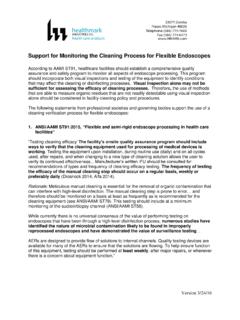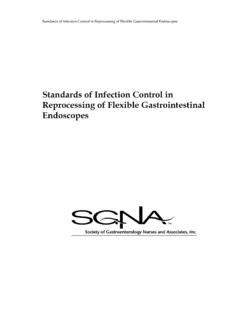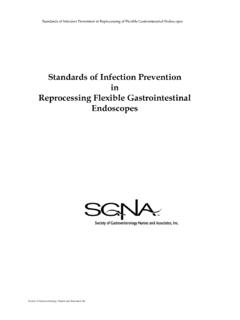Transcription of National Endoscopy Programme
1 National Endoscopy Programme Decontamination Standards for flexible endoscopes Updated March 2008. Introduction Providing an effective endoscope decontamination Members of the GRS Endoscope Decontamination service within a safe environment is an essential Working Party: requirement for every Endoscopy unit in England. (DoH Health Act, 2006) The guidance and standards Libby Thomson - Lead Nurse, St George's Endoscopy for decontamination practice are available in various Training Centre, Nurse Lead BSG Working Party on forms, from a number of agencies. In response to Endoscope Decontamination requests from the service, the NHS National Endoscopy Programme established a working group to design a Miles Allison - Chair of BSG Working Party on Endoscope quality assurance tool that would encompass all the Decontamination / Clinical Lead National Endoscopy decontamination standards in a format which would be Programme for Wales / UK CJD incidents Panel relevant to the end users.
2 This tool should be used by Endoscopy teams to self assess their decontamination Tina Bradley - Laboratory Manager environment and processes against National standards. Hospital Infection Research Laboratory, Birmingham This document has been developed to support the Geoff Sjogren - Decontamination Lead - Surrey/Sussex safety item of the Global Rating Scale (GRS) and is used to assess local practice as part of the JAG Accreditation David Green -Lead Nurse Infection Control process. The document is based on the BSG Guidelines Bradford Teaching Hospitals for Decontamination of Equipment for Gastrointestinal Endoscopy 2008. Pam Hardman - Senior Nurse Matron Endoscopy East & North Hertfordshire NHS Trust The document should be used as the basis for departmental policy and procedure documentation Roger Leicester - Director of Endoscopy Services which will need to be produced as evidence during St George's Endoscopy Training Centre external assessments together with other forms of evidence outlined in the document.
3 This document has been developed in consultation with the BSG, NHS and Industry. To download this document go to: Pdf format Word Format National Endoscopy Programme - Decontamination Standards for flexible endoscopes 01. DECONTAMINATION STANDARDS FOR flexible endoscopes . Evidence Yes No Action Plan Operational Management Written procedures for decontamination of Endoscopy equipment are available and reviewed every 2 years. Nominated decontamination lead at Trust board level. Organisational structure Interview with Trust Lead Operational decontamination manager who has Trust (i) clear line management; decontamination (ii) representation on Trust committee whose remit includes policy decontamination; and (iii) ability to act on any concerns regarding decontamination practice from Endoscopy personnel Overall decontamination training lead attached to the Interview with Endoscopy unit.
4 Unit Lead Involvement from the infection control department and a Interview with named microbiologist in managing and maintaining the Infection Control service. Decontamination matters regularly discussed in Endoscopy Endoscopy User Group User Group meetings. agenda / minutes A record of adverse incidents and evidence of appropriate Adverse incident book action taken. and action plans Evidence of bi-annual audits of decontamination processes Audits and action and action taken. plans Evidence of annual Trust audit on decontamination Audit and action plans processes and action taken presented to Trust Board. There is evidence that detergents, disinfectants, Records of staff endoscopes , Automated Endoscope Reprocessing machines training (AER) and disinfectant generators are used in accordance with the manufacturers' guidelines. There is evidence of document control for standard operating procedures.
5 There are written procedures for out of hours emergency Out of hours protocol Endoscopy to ensure that it only occurs if there is someone Training & Assessment available who is trained in endoscope decontamination. record 02 National Endoscopy Programme - Decontamination Standards for flexible endoscopes Evidence Yes No Action Plan Environment, design and layout There is a: (i) designated and dedicated decontamination area (ii) separate dirty, clean and storage areas (iii) one-way flow for equipment. There is adequate ventilation and extraction in place to Estates records protect staff, patients and the public from exposure to hazardous substances. There is a double sink for the washing and rinsing of endoscopic equipment within the decontamination area which is sufficient to meet required capacity and throughput. Sinks should be: (i) of adequate size to ensure manual cleaning is car ried out effectively and (ii) positioned to minimise the risk of occupational injury There is a dedicated hand washing basin that is used in the decontamination area.
6 Safety Endoscopy decontamination areas should be designed to ensure an effective and efficient service that does not harm staff, patients or the public. There is evidence of COSHH risk assessments. Risk assessments Units should have evidence of their risk assessment for the use of Personal Protective Equipment All staff involved in decontamination have access to and Staff interviews wear appropriate personal protective equipment including full face visors, single-use gloves and aprons. During manual cleaning, forearms should be protected. Staff must wear protective equipment as instructed by the manufacturers' when mixing and loading chemicals into the AER. National Endoscopy Programme - Decontamination Standards for flexible endoscopes 03. Evidence Yes No Action Plan Respiratory protection is employed against chemical and microbial hazards in line with COSHH assessments.
7 Health surveillance for staff should be considered, in OH policy consultation with occupational health departments for Staff interviews exposures to disinfectants that are not aldehydes or chlorine-releasing agents or other strong irritants. If agents similar to glutaraldehyde are used, then health surveillance should be carried out. There is a policy and equipment available for spillages; Spillage policy chemicals, detergents, body fluids. Site visit In the event of the inability to provide an automated Evidence of action decontamination system, the Endoscopy activity must taken cease until the automated process is regained. Manual Staff interviews disinfection and rinsing are not acceptable. A procedure must be in place for the safe and proper disposal of any residual chemicals, either residual container quantities or quantities beyond their expiration date, used in the Endoscopy reprocessing area.
8 The procedure should include disposal guidelines according to the nature of the detergent or disinfectant, and should specify who is responsible for such disposal. Staff Training There is evidence of a structured induction, training and re- Competency Training validation Programme for staff involved in decontamination package using a competency assessment tool. There is evidence of mandatory training records eg. manual Training records handling. The Decontamination E-learning training package is used as part of a decontamination training package. Training programmes are based on: Training programmes/. Competence 21 of the National Endoscopy competence assessment records framework and; Competencies 1 to 6 of the Decontamination Competence Framework. Competence is measured and documented using an assessment framework. Training programmes should include: identification of individual endoscopes and all 04 National Endoscopy Programme - Decontamination Standards for flexible endoscopes Evidence Yes No Action Plan associated channels design and function of endoscopes theory on decontamination, microbiology, detergents, disinfectants and AERs health & safety and infection control knowledge and skills assessment on assembly and dismantling of scopes, pre-cleaning, manual cleaning, reprocessing accessories and ancillary equipment, disinfection and use of the AER, drying, transportation, storage, tracking/traceability, maintenance, testing and validation.
9 There is evidence of COSHH training. Training records There is evidence of staff training from the manufacturers Training records of AERs and generators. Instructions for decontamination processes including Top Ten Tips from MHRA are visually displayed. Up-to-date manufacturers' (endoscope, AER and chemical). instructions and departmental policies are easily accessible. There is evidence that staff who undertake testing and Training records validation of AERs are trained. Stages of endoscope decontamination Decontamination of endoscopes is undertaken at the beginning and end of each list, and between patients, by trained staff in a dedicated room. There is evidence that Trusts have undertaken a risk Risk assessment assessment as to the need for manual cleaning and automatic disinfection before endoscopes are used at the start of each day. All endoscopes have a record of their decontamination Tracking system status such that they are fit for use on patients.
10 Preliminary cleaning Endoscope channels are flushed immediately following the procedure and the external surfaces socially cleaned, ideally by the endoscopist. An air/water flushing valve is used in endoscopes with combined air/water channels. National Endoscopy Programme - Decontamination Standards for flexible endoscopes 05. Evidence Yes No Action Plan Channels are checked for patency during this process. endoscopes are transported to the decontamination area in a covered receptacle that is of an appropriate size so as to avoid contaminating the environment. Manual Cleaning Endoscope valves and detachable distal tips are removed from the endoscope prior to manual cleaning. endoscopes are leak tested and inspected for damage prior to manual cleaning. Manual cleaning is carried out in a dedicated sink and is filled with water to an identified level to ensure correct detergent concentration and temperature in accordance to manufacturers instructions.






